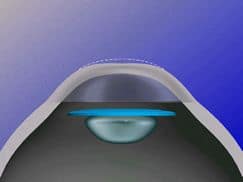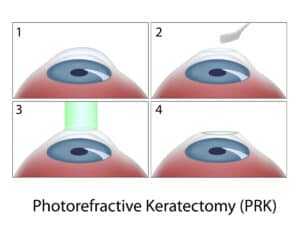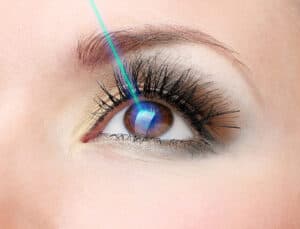 PRK (photorefractive keratectomy) is a laser vision correction procedure performed by Dr. Brian at his office in Beverly Hills. The procedure involves gently moving the surface skin of the cornea and applying a laser to reshape the outer cornea.
PRK (photorefractive keratectomy) is a laser vision correction procedure performed by Dr. Brian at his office in Beverly Hills. The procedure involves gently moving the surface skin of the cornea and applying a laser to reshape the outer cornea.
PRK was the first type of laser eye surgery for vision correction. PRK preceded development of LASIK.
PRK does not require the creation of a flap; instead, a solution is applied to the eye and the laser is then applied to the surface of the cornea to reshape it. The surface skin heals over the treated area. The visual results of PRK are similar to LASIK; however, vision is typically slower to recover. This 5-10 minute procedure can treat nearsightedness, farsightedness, and astigmatism. Potential benefit is improved vision and potential risks are infection, inflammation and haze, among others. That is the reason that Dr. Brian and every staff member here are highly “detail-oriented” about each step of the process for every patient.
15 year-old PRK is very different than the modern-day PRK. Specialized drops and contact lenses are used postoperatively so the procedure is not typically painful in the way “old style” PRK was a decade ago.
If you had a cornea transplant and are experiencing vision problems from Astigmatism and other distortions, please click here to learn how you can be helped with Dr. Brian’s specialized PRK for cornea transplants.
Professional Basketball Player Rudy Gay discusses how PRK with Dr. Brian changed his career.
Be a “Fly on the Wall” and Watch Jessica, BWVI staff member, have PRK to Correct Nearsightedness
What to Expect During Your Evaluation for PRK
Your thorough consultation with Dr. Brian will ensure that you are a good candidate for PRK. This will include evaluating:
- Moisture level of eyes – evaluation for the risk of Dry Eye
- Cornea curvature – ensuring no early signs of degenerative changes
- Cornea thickness – ensuring your cornea is thick enough and safe to have PRK
- Pupil size – to determine risk for halos/glare during night-time driving postoperatively
| WHY PRK | POTENTIAL BENEFIT to PATIENT |
| Preferred for patients who are very apprehensive about LASIK | Less involved than LASIK |
| Preferred for patients with thin cornea thickness | Less depth of laser treatment than LASIK |
| Preferred for patients with previous RK(radial keratotomy) | Minimizes invasiveness for laser correction |
PRK Procedure Details
 Prior to PRK, Dr. Brian will take detailed digital images of your eye. Software will create a detailed map of your eye that he can follow to achieve the crispest vision possible. You will receive anesthetic eye drops that numb your eyes. A spring painlessly keeps your eyelids open so that you do not blink during the surgery.
Prior to PRK, Dr. Brian will take detailed digital images of your eye. Software will create a detailed map of your eye that he can follow to achieve the crispest vision possible. You will receive anesthetic eye drops that numb your eyes. A spring painlessly keeps your eyelids open so that you do not blink during the surgery.
Dr. Brian begins by carefully polishing off the epithelium, the outer layer of the cornea, with a high-tech polishing tool. He then switches to a separate laser that gently reshapes the corneal tissue so that incoming light can be refracted and focused to the retina correctly. If both eyes are being treated, the process is repeated for the other eye. The whole process is complete in approximately 15 minutes.
Why Dr. Brian May Recommend PRK Instead of LASIK to Some Patients
Not all patients are good candidates for LASIK, including those who have thin corneas. The same is true for some people who have had previous eye surgery (cataract surgery, refractive lens exchange).
Although LASIK has an exceedingly low rate of complications, PRK has an even lower rate because it avoids creating a flap in the epithelium. Patients who are especially nervous about safety, or athletes who play contact sports that may be more prone to suffering an eye injury, may be better suited for PRK.
Recovering from PRK
Advancements in surgical techniques and technology have vastly improved the results and recovery time after PRK. Many of Dr. Brian’s patients are surprised at how quickly they recover vision after PRK and are able to return to their normal daily lifestyle.
What Happens Right After Your PRK Surgery
At the conclusion of your PRK procedure, a bandage contact lenses will be placed in your eyes to protect your healing corneas. Do not remove the lenses (Dr. Brian will do so).
Right after your procedure, you will relax in our recovery suite, where our team will keep an eye on you. General anesthesia is not used, so you will not feel tired or groggy. However, your vision will be blurry and/or hazy, and you will need a companion to drive you home and help you get into a comfortable resting position. We will provide a patch or shield to wear over your eyes to make the trip home a little more comfortable.
Most PRK patients spend the remainder of the day napping or resting their eyes. Dr. Brian encourages you to avoid any visual-intensive activities, such as watching long hours of television or working on a computer, during this time. Instead, you may choose to listen to an audiobook or podcast, or do some light reading.
Your eyes will likely feel slightly uncomfortable for a day or two. You can take over-the-counter pain relievers if necessary. If the discomfort persists or increases, please let our office know. Other common PRK aftereffects include dryness, burning, itching or the sensation that a foreign object is stuck in your eyes.
Dr. Brian will prescribe eye drops and provide you with instructions for using the drops. The medicine will help lubricate your eyes and prevent infection and other complications after surgery. Dr. Brian may also ask you to wear your eye shield when you sleep to avoid accidentally touching your eyes.
Things That Are Off-limits After PRK Surgery
Rubbing your eyes
Do your best to avoid rubbing or pressing on your eyes in the days immediately following PRK. If you get an eyelash or piece of debris stuck in your eye, use artificial tears to flush it out instead of your fingers.
Getting your eyes wet
You can bathe as soon as the day after your PRK procedure, but do not get water, soap or shampoo in your eyes. Refrain from swimming or going in hot tubs until Dr. Brian says it is safe.
Getting cosmetics or topical products in your eyes
It is also important that you take precautions to avoid getting makeup, lotion, hairspray or similar products in your eyes. These products can irritate or harm your eyes as your cornea’s epithelial cells regenerate.
Follow Up with Dr. Brian
Dr. Brian will follow up with you throughout your PRK recovery and monitor your healing eyes. He can recommend when to resume driving, going back to work and exercising. Normally PRK patients feel confident enough to get behind the wheel and go back to the office within a few days of surgery.
PRK Surgery FAQ
Can I stop wearing prescription lenses after having PRK?
 PRK is a highly effective way to correct refractive errors like nearsightedness, farsightedness, and astigmatism. Almost all patients achieve 20/40 vision or better, dramatically reduces their dependence on prescription lenses. However, PRK does not prevent presbyopia (age-related farsightedness), which starts to affect near vision after middle age. Patients affected by presbyopia may need to rely on reading glasses in some situations. Dr. Brian used Fortified CK for that.
PRK is a highly effective way to correct refractive errors like nearsightedness, farsightedness, and astigmatism. Almost all patients achieve 20/40 vision or better, dramatically reduces their dependence on prescription lenses. However, PRK does not prevent presbyopia (age-related farsightedness), which starts to affect near vision after middle age. Patients affected by presbyopia may need to rely on reading glasses in some situations. Dr. Brian used Fortified CK for that.
How much does PRK cost?
Dr. Brian’s prices reflect his experience in the field of ophthalmology and the state-of-the-art equipment he uses to achieve crisp, clear vision for his patients. Patients are much more likely to be dissatisfied with their results if they choose a “budget” (inferior) laser eye center. Fees for your eye care can be discussed during a consultation. Easy financing options are available with monthly payment as low as a few hundred dollars a month and special zero percent interest (which many people feel like is free money given the high interest rates these days). Most of Dr. Brian’s patients consider PRK a sound investment since it helps patients to save money on prescription lenses (like contact lenses) over the long term, in addition to the improvement in quality of life which is priceless.
At what age can I have PRK?
The only formal age requirement for PRK is that patients must be at least 18 years old. Dr. Brian usually suggests that patients wait until age 21 to ensure that vision has stabilized, since eyes can continue to grow and develop through one’s teenage years. Most patients who have PRK do so in their 20s and 30s; however, many patients 40 and older are also considered good candidates for PRK.
Does PRK hurt?
Most patients feel very little during the surgery, with any discomfort being temporary and minimal. Although mild irritation is common after PRK, you may take pain medication as necessary for a few days to keep discomfort at bay.
What Is PRK and How Does It Work?
PRK (photorefractive keratectomy) is a type of laser eye surgery that reshapes the cornea to correct vision issues like nearsightedness, farsightedness, and astigmatism. Unlike LASIK, PRK does not involve creating a corneal flap. Instead, the outer layer of the cornea is gently removed, allowing the laser to reshape the underlying tissue. Over time, the surface layer heals naturally as your vision improves.
How Do You Know if You’re a Candidate for PRK?
 You may be a good candidate for PRK if you have thin corneas, dry eyes, or corneal irregularities that make LASIK unsuitable. PRK is also ideal if you lead a physically demanding lifestyle, are in the military, or have a career where eye protection is crucial. Dr. Brian provides a personalized evaluation to determine your eligibility for PRK. PRK is also indicated many years after LASIK for vision touch up.
You may be a good candidate for PRK if you have thin corneas, dry eyes, or corneal irregularities that make LASIK unsuitable. PRK is also ideal if you lead a physically demanding lifestyle, are in the military, or have a career where eye protection is crucial. Dr. Brian provides a personalized evaluation to determine your eligibility for PRK. PRK is also indicated many years after LASIK for vision touch up.
What Should You Do Before Your PRK Evaluation?
Stop wearing soft contact lenses 1 day prior to your evaluation. If you wear rigid gas permeable lenses, you may need to stop wearing them for a longer period. Removing contacts ahead of time helps ensure your corneas return to their natural shape for accurate testing.
What’s the Difference Between PRK, LASIK, and LASEK?
PRK removes the outer corneal layer called epithelium without creating a flap. LASIK creates a corneal flap, while LASEK loosens and moves the surface cells aside. PRK is often preferred when flap creation may not be ideal, offering added safety for certain individuals and lifestyles.
Can Both Eyes Be Treated at the Same Time?
Yes, both eyes can be treated during the same appointment. Dr. Brian will evaluate your vision and goals to determine if simultaneous treatment is appropriate for your case.
How Long Does It Take to See Clearly After PRK?
Initial improvements typically occur within a few days, with most patients achieving functional vision in about a week. Full visual clarity and stability may take up to a month or more, depending on individual healing.
When Can You Resume Driving After PRK?
Most patients can drive within five to seven days following PRK surgery. Dr. Brian will monitor your vision and provide clear guidance on when it is safe to resume driving.
Can You Exercise After PRK?
You can return to light physical activity within a few days. However, you will initially want to avoid high-impact exercises, swimming, or activities that involve sweat or water near the eyes. Most importantly, follow Dr. Brian’s aftercare instructions for optimal results.
What If You Accidentally Rub Your Eyes After PRK?
Rubbing your eyes soon after PRK can disrupt healing. If this happens, contact Dr. Brian’s office for advice, especially if you notice pain, vision changes, or discomfort.
Does Insurance Cover PRK?
PRK is usually considered an elective procedure and not covered by most insurance plans. Some vision plans may offer discounts or partial reimbursement. Financing options may also be available.
Is PRK a Good Option for Military Personnel and First Responders?
PRK is often recommended for those in physically demanding roles. It eliminates the need for a corneal flap, making it safer in environments where eye trauma is a risk.
What Are the Long-Term Results of PRK?
PRK offers excellent, long-lasting vision correction. Results are stable over time, although age-related vision changes may still occur. Most patients enjoy years of clear vision without the need for corrective lenses.


